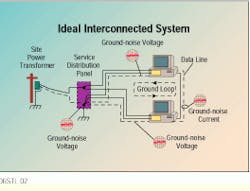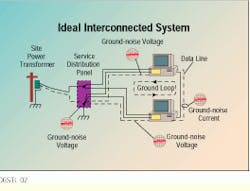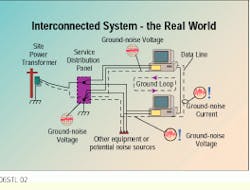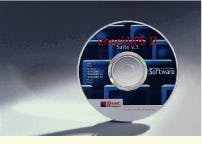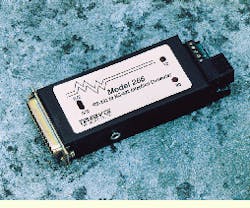Ground noise is a misunderstood problem of data networks
Ground noise is a misunderstood problem of data networks
Intersystem ground noise, often mistaken for common-mode noise, can corrupt data transmissions and damage network hardware.
Neil Rasmussen, American Power Conversion
An uninterruptible power supply is an essential part of a premises computer network, but it cannot completely protect data-processing equipment from all power-related problems. In working with installers of business computer systems, American Power Conversion has identified several installation configurations that pose special risks.
Most power-protection equipment for data communications equipment is designed to protect the loads that are attached to the computer. In the ideal case, no connection point to the computer exists except for the alternating-current (AC) power cord. This allows the power-protection equipment complete control over any noise or transients that may attempt to enter the computer from the outside world.
In the real world, computers are usually interconnected to other remote devices via network wiring, printer data lines and telephone modem lines. AC power-protection equipment cannot stop transients from entering the computer via these data connections. In fact, these connections may allow a common and potentially dangerous type of AC power problem to damage hardware or data: intersystem ground noise, which cannot be corrected using typical power-protection equipment.
Safety grounding
All computer equipment comes with three-wire, grounding-type AC power connectors. Many other types of equipment, such as desk lamps, have only two-wire, ungrounded plugs, because only two wires are needed to deliver AC power.
The third wire in a three-wire plug is a safety ground wire that is connected to any exposed metal parts on computer equipment. The grounding wire at the wall receptacle is linked to copper water pipes or structural metal parts in the building. This configuration protects a computer user from electrical shock if he or she comes in contact with computer equipment and exposed metal at the same time.
For safety purposes, the connector shells of RS-232 connectors, network attachment unit interface (AUI) and printer ports, for example, are considered to be exposed metal parts. For this reason, the voltages at the connector pins must be grounded, or they have to be small voltages with respect to ground. The result is that in virtually all computer equipment, the common wire or ground reference of the central processing unit (CPU) is connected to the safety grounding wire (and the enclosure) of the computer equipment.
In a system that includes equipment interconnected via ground referenced data lines, this safety grounding arrangement leads to a conflict--every interconnected device has two connections that are attempting to establish the common reference voltage for the data communications circuit. The common wire in the data line, which connects the device to other equipment, is in conflict with the device`s safety grounding wire. This situation is sometimes known as a ground loop.
The existence of this ground loop can lead to differences in the common reference voltage existing between interconnected devices, which in turn, can damage hardware and corrupt data. These ground voltage differences between interconnected devices must not be confused with other disturbances, such as common-mode noise, normal-mode noise, electromagnetic interference and radio-frequency interference. Ground voltage differences are referred to as intersystem ground noise.
A common misunderstanding in the field of computer power protection is the difference between intersystem ground noise and common-mode noise. Intersystem ground noise exists between the ground wires supplying interconnected computers. Common-mode noise exists between the power conductors and the ground wire in the computer`s power cord.
Therefore, freestanding computers that are not interconnected via data lines cannot experience intersystem ground noise. It is possible, then, for a computer to experience severe common-mode noise while suffering from no intersystem ground noise, and vice versa; the two problems are completely independent.
One of the reasons for the confusion stems from the fact that power-protection equipment can reduce common-mode noise but it cannot alleviate or correct intersystem ground noise. Some power-protection equipment manufacturers may have an interest in having users believe that the two kinds of noise are equivalent; they make products that correct common-mode noise and want to increase their sales. In fact, the emphasis is usually on common-mode noise, rather than on intersystem ground noise, because sales and technical literature from power-protection equipment manufacturers are the leading sources of information on the subject.
Effects and sources
For an ideal interconnected system, the grounding wires from all of the interconnected equipment come from the same source, ensuring that, initially, they have the same voltage. No current flows in any of the ground wires, nor are they subject to any magnetic fields. This ensures that there can be no voltage drop along the ground wires. The result is that all points along all of the ground wires are at the same voltage, and no intersystem ground noise exists between devices attached at various points along the grounding system.
Unfortunately, significant electrical effects can prevent this ideal scenario from happening. In some cases, the deviation from the ideal can result in hardware damage and in corruption of data.
In a system experiencing intersystem ground noise, interconnected devices are subjected to different ground-noise voltages, thereby causing ground-noise current in the data line connecting the devices. For example, the offending ground noise could result from noise current injected into the system ground of one of the computers by attached peripheral equipment.
Intersystem ground noise can result from a variety of problems, including ground noise injection, ground faults, ground currents and lightning-induced voltages.
Ground-noise injection--Although the safety ground wire is intended for grounding the equipment enclosure, all computer equipment uses this wire to provide a reference point to filter out unwanted emissions of radio-frequency interference. Common- and normal-mode electrical noise from the power line can be injected into the ground wire by the filter present in the power supply of each computer or workstation. Improperly designed surge suppressors may contribute to this problem.
This injected noise current can cause a noise voltage between the common reference of the interconnected equipment. The opportunity for data transmissions to become corrupted by noise voltage is increased as the length of the data line is increased.
Ground faults--If the interconnected devices are on different electrical circuits in the building, and one of these circuits is shared by unrelated equipment that experiences an insulation failure, then a ground fault can occur. As the circuit breaker trips, a very large fault current will be injected into the safety ground wire. This current will produce a momentary ground voltage surge at the computer equipment.
The size of the voltage surge can range from a few volts to more than one-half of the rated power voltage (either 120 or 23OV AC), depending on the quality of the grounding system. The surge may result in a voltage difference between the common reference points on the interconnected equipment, which can easily exceed the data-signal safety voltage rating. Destruction of input/output drivers and CPU motherboards can result.
Ground currents--This is the most common problem identified with intersystem ground noise. If the CPU and workstation are supplied by different electrical subpanels (or circuit breaker boxes), whether in the same or different buildings, then many problems can lead to differences in the ground voltage present at the interconnected devices.
Depending on the local or national electrical codes in effect at a given location, many different wiring systems are possible between subpanels. Most of these interpanel wiring systems do not guarantee that the ground voltages supplied by the subpanels will be equal. In many cases, the interpanel ground connections are themselves part of other ground loops, such as those created by connection to building frame members. These ground loops are unrelated to the ground loops caused by the interconnection of data communications devices.
A variety of situations can then give rise to dangerous ground-noise voltages between subpanels, including nearby lightning strikes to ground, lightning-induced currents in ground loops external to the ground loop caused by data-device connections, poor building grounding (for instance, in sandy soil), fault currents such as breaker tripping in apparently unrelated buildings or circuits, and nearby electrical repair work.
The overall effect of these ground currents may be a voltage difference between the common reference points of the networked devices that can easily exceed the data-cable safety voltage rating. Destruction of data interface drivers and CPU motherboards can result. Another common side effect of this problem is heating of the data cabling, which is recognizable when the cable becomes warm to the touch.
Lightning-induced voltages--In this potentially damaging form of ground-noise voltage, the ground loop acts as an antenna. Nearby lightning strikes create enormous electromagnetic-pulse noise that is received by the antenna. Therefore, a large circulating current in the ground loop can be created by passing electrical storms. This current may cause the voltage difference between the common reference points of interconnected devices to exceed the safety voltage rating. Damage to the data-interface driver cards is common, and propagation of the damage into the CPU motherboard is possible.
The area of the ground loop determines the magnitude of the problem. In rare cases, other types of equipment, such as nuclear magnetic resonance and magnetic resonance imaging machines in hospitals, may create electromagnetic pulses that are picked up by the ground loop.
It may appear that the source of all of these problems is the ground loop caused by the electrical safety ground. In many cases, disconnection of this ground at the workstation may prevent the problems. However, ground-wire disconnection should never be performed because it is illegal and presents a severe shock hazard. It is sometimes suggested that an isolation transformer be used to solve the ground-loop problem. This will not work, though, because all safety agencies require that the ground wire of an isolation transformer be passed between the input and output, so only the power wiring may be isolated.
Some network wiring is completely isolated and does not create ground loops when used to interconnect equipment. In this case, intersystem ground noise can exist, but it will have no effect on the system. An example of such network wiring is that of 10Base-T Ethernet. However, not all network wiring systems are as immune to ground noise as this one.
Examples of interconnections that are especially subject to intersystem ground noise are RS-232 data links to terminals, long wires connecting printers and AUIs to the network.
Proper procedures to prevent problems when using RS-232 connections include avoiding wiring runs of more than a few meters in length, if possible; installing high-performance surge suppressors on modem connections; specifying properly constructed RS-232 cables; and using optical fiber or isolators for long wiring runs to lower the risk of exposure.
When using AUIs in token ring networks, always ensure that the hub and all end-user equipment connected to it are plugged into outlets that are wired to the same electrical-distribution panel. Keep AUI wiring under 10 meters, if possible, and make sure that all users fed from the hub, and the hub itself, are fed from the same circuit breaker. q
Neil Rasmussen is vice president of engineering at American Power Conversion`s research and design facility in Billerica, MA.
In an ideal interconnected network, the grounding wires from all equipment come from the same source, so that no ground loop develops and there is no ground-noise voltage.
When other equipment or potential noise sources are linked to a network, the potential exists for creating a ground loop that leads to ground-noise current at the data equipment. This current can potentially corrupt data transmissions and damage computer hardware.
Several manufacturers now offer power-management software with their hardware. CheckUPS II software from Best Power (Necedah, WI) is bundled free with the company`s equipment and includes power-management, monitoring and shutdown functions.
This new interface converter from Telebyte Technology Inc. (Greenhaven, NY) protects network equipment from surges of more than 10 kilovolts, according to the manufacturer. The device optically isolates RS-232 from RS-422 circuitry.
